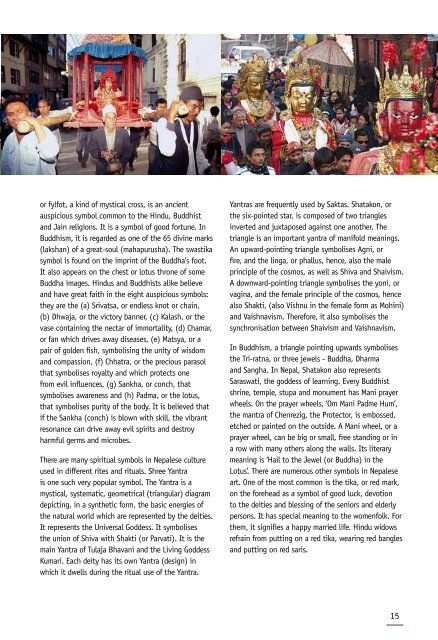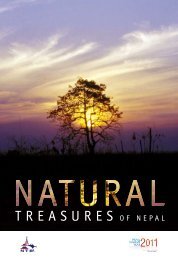treasures of nepal
treasures of nepal
treasures of nepal
- No tags were found...
You also want an ePaper? Increase the reach of your titles
YUMPU automatically turns print PDFs into web optimized ePapers that Google loves.
or fylfot, a kind <strong>of</strong> mystical cross, is an ancientauspicious symbol common to the Hindu, Buddhistand Jain religions. It is a symbol <strong>of</strong> good fortune. InBuddhism, it is regarded as one <strong>of</strong> the 65 divine marks(lakshan) <strong>of</strong> a great-soul (mahapurusha). The swastikasymbol is found on the imprint <strong>of</strong> the Buddha’s foot.It also appears on the chest or lotus throne <strong>of</strong> someBuddha images. Hindus and Buddhists alike believeand have great faith in the eight auspicious symbols:they are the (a) Srivatsa, or endless knot or chain,(b) Dhwaja, or the victory banner, (c) Kalash, or thevase containing the nectar <strong>of</strong> immortality, (d) Chamar,or fan which drives away diseases, (e) Matsya, or apair <strong>of</strong> golden fish, symbolising the unity <strong>of</strong> wisdomand compassion, (f) Chhatra, or the precious parasolthat symbolises royalty and which protects onefrom evil influences, (g) Sankha, or conch, thatsymbolises awareness and (h) Padma, or the lotus,that symbolises purity <strong>of</strong> the body. It is believed thatif the Sankha (conch) is blown with skill, the vibrantresonance can drive away evil spirits and destroyharmful germs and microbes.There are many spiritual symbols in Nepalese cultureused in different rites and rituals. Shree Yantrais one such very popular symbol. The Yantra is amystical, systematic, geometrical (triangular) diagramdepicting, in a synthetic form, the basic energies <strong>of</strong>the natural world which are represented by the deities.It represents the Universal Goddess. It symbolisesthe union <strong>of</strong> Shiva with Shakti (or Parvati). It is themain Yantra <strong>of</strong> Tulaja Bhavani and the Living GoddessKumari. Each deity has its own Yantra (design) inwhich it dwells during the ritual use <strong>of</strong> the Yantra.Yantras are frequently used by Saktas. Shatakon, orthe six-pointed star, is composed <strong>of</strong> two trianglesinverted and juxtaposed against one another. Thetriangle is an important yantra <strong>of</strong> manifold meanings.An upward-pointing triangle symbolises Agni, orfire, and the linga, or phallus, hence, also the maleprinciple <strong>of</strong> the cosmos, as well as Shiva and Shaivism.A downward-pointing triangle symbolises the yoni, orvagina, and the female principle <strong>of</strong> the cosmos, hencealso Shakti, (also Vishnu in the female form as Mohini)and Vaishnavism. Therefore, it also symbolises thesynchronisation between Shaivism and Vaishnavism.In Buddhism, a triangle pointing upwards symbolisesthe Tri-ratna, or three jewels - Buddha, Dharmaand Sangha. In Nepal, Shatakon also representsSaraswati, the goddess <strong>of</strong> learning. Every Buddhistshrine, temple, stupa and monument has Mani prayerwheels. On the prayer wheels, ‘Om Mani Padme Hum’,the mantra <strong>of</strong> Chenrezig, the Protector, is embossed,etched or painted on the outside. A Mani wheel, or aprayer wheel, can be big or small, free standing or ina row with many others along the walls. Its literarymeaning is ‘Hail to the Jewel (or Buddha) in theLotus’. There are numerous other symbols in Nepaleseart. One <strong>of</strong> the most common is the tika, or red mark,on the forehead as a symbol <strong>of</strong> good luck, devotionto the deities and blessing <strong>of</strong> the seniors and elderlypersons. It has special meaning to the womenfolk. Forthem, it signifies a happy married life. Hindu widowsrefrain from putting on a red tika, wearing red banglesand putting on red saris.15




